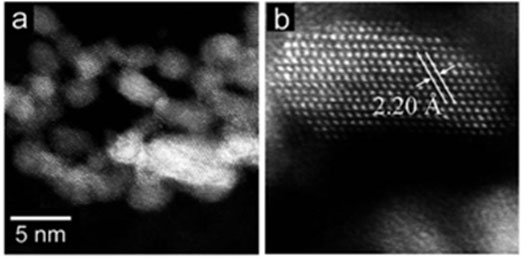Scientists in Japan and India have developed a reusable, high-performance catalyst based on flat-shaped ruthenium nanoparticles (Ru-NP) for the production of valuable chemicals. Due to its demonstrated durability, the catalyst could be widely used in the large-scale production of many types of dyes, detergents, agrochemicals and pharmaceuticals.

Figure 1. The microstructure of the Ru-NP catalyst
Analysis using high-angle annular dark-field scanning transmission electron microscopy (HAADF-STEM) revealed: (a) small and flat ruthenium patches over a large domain and (b) the lattice spacing corresponding to that of face-centered-cubic ruthenium nanoparticles.
A study led by researchers at Tokyo Institute of Technology (Tokyo Tech) has shown that nanoscale changes in surface structure can vastly improve the performance of metal catalysts used in the production of primary amines1, an important class of compounds in the chemical industry.
The researchers developed a ruthenium-based catalyst composed of a large number of atomically active facets on their flat surfaces.
Compared to conventional metal-supported catalysts, the new catalyst, with its highly active surface structure, achieved an overwhelmingly high catalytic turnover.
The study involved comparing how well different kinds of metal catalysts could convert biomass-derived furfural to furfurylamine. This served as a model reaction for reductive amination2, the main process used to yield primary amines.
The new catalyst exhibited a turnover frequency of 1,850 per hour. This figure represents a six-fold increase in efficiency over a metal-supported catalyst (Ru/Nb2O5) developed previously by some of the same team members, including Michikazu Hara and Keigo Kamata at Tokyo Tech's Institute of Innovative Research.
"To the best of our knowledge, the Ru-NP catalyst exhibited the highest turnover frequency among the metal catalysts reported to date for the reductive amination of furfural to produce furfurylamine," the team says in their study published in Chemical Science.
Further experiments to test the reusability of the new catalyst for the reductive amination of furfural showed "no noticeable decrease in activity, even after four reuses" the researchers say, highlighting the catalyst's robustness.
The secret behind the catalyst's exceptional performance lies in its distinctive structure and shape. Usually, Ru has a hexagonal close-packed structure3 that limits catalytic performance. In contrast, the new catalyst has a high proportion of so-called flat-shaped, pristine face-centered-cubic4 ruthenium nanoparticles at the surface, which serve as active sites with weak electron-donating ability. It is this feature that is thought to be critical to enabling efficient and selective reductive amination of various carbonyl compounds.
As well as facilitating the production of biomass-derived amines, the new catalyst could also help meet the demands of the wider fine chemical industry.
The present study was supported by organizations including the Japan Science and Technology Agency's Advanced Low Carbon Technology (ALCA) R&D Program and the Novel Cheap and Abundant Materials for Catalytic Biomass Conversion (NOVACAM) project, as well as the European Commission Directorate-General for Research and Innovation.
1 Primary amines
Industrially important compounds used widely as intermediates in the preparation of pharmaceuticals, dyes and surfactants.
2 Reductive amination
A reaction that involves converting a carbonyl group to an amine (a derivative of ammonia) via an imine (a compound containing a carbon–nitrogen double bond).
3 Hexagonal close-packed structure
A dense crystalline structure in which each unit is in contact with six neighboring units. Metallic Ru normally has this type of structure. Owing to their symmetry, the hexagonal close-packed structure and the face-centered cubic system (see figure 1) represent two simple regular lattices that achieve the highest average density.
4 Face-centered-cubic
A type of lattice or "packing" system in a crystal structure in which one atom is located at each corner of each unit and at the center of each face.
Reference
Authors : |
Debraj Chandraa, Yasunori Inoueb,c, Masato Sasasec,d, Masaaki Kitanoc,d, Asim Bhaumike, Keigo Kamatab, Hideo Hosonob,c,d and Michikazu Harab,c,f,* |
Title of original paper : |
A high performance catalyst of shape-specific ruthenium nanoparticles for production of primary amines by reductive amination of carbonyl compounds |
Journal : |
Chemical Science |
DOI : |
|
Affiliations : |
a World Research Hub Initiative (WRHI), Institute of Innovative Research, Tokyo Institute of Technology, Japan
b Laboratory for Materials and Structures, Institute of Innovative Research, Tokyo Institute of Technology, Japan
c ACCEL, Japan Science and Technology Agency, Japan
d Materials Research Center for Element Strategy, Tokyo Institute of Technology, Japan
e Department of Materials Science, Indian Association for the Cultivation of Science, India
f Advanced Low Carbon Technology Research and Development Program (ALCA), Japan Science and Technology Agency (JST), Japan
|
. Any information published on this site will be valid in relation to Science Tokyo.



